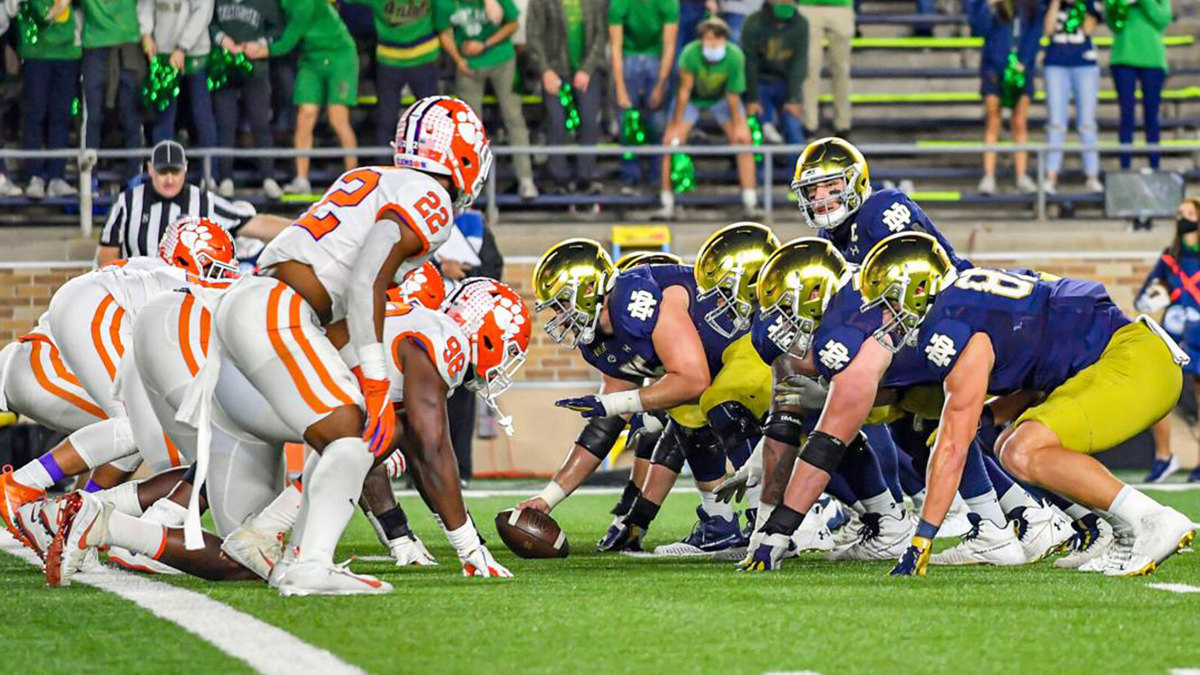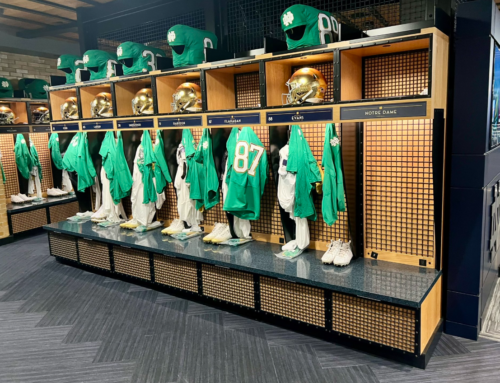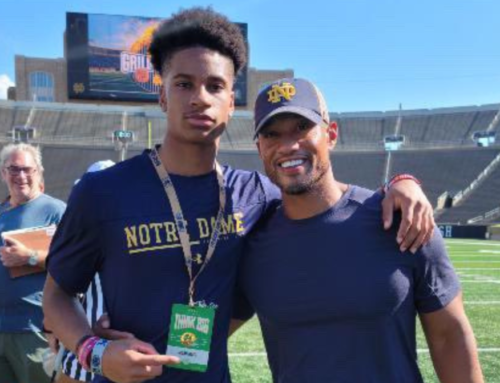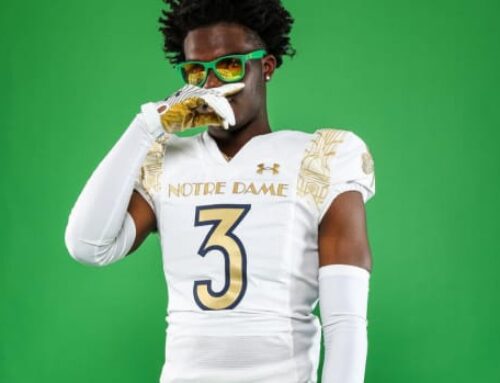Over at ESPN+ a while back I was reading how Bill Connelly compared Notre Dame today to Clemson in the 2012-14 window with how the Irish were recruiting more blue-chips in the present than the Tigers were back then. So, I want to do 2 things in this two-part series. One, compare Notre Dame’s 2012-14 recruiting with Clemson over the same time period. Two, compare Notre Dame’s 2019-21 recruiting to that same 2012-14 Clemson time period to see where the Irish stack up.
We’ll start with the defense today.
Notre Dame Recruit 2012-14
Clemson Recruit 2012-14
Notre Dame Recruit 2019-21
Defensive End
Notre Dame, Isaac Rochell 0.948
Notre Dame, Andrew Trumbetti 0.936
Notre Dame, Rylie Mills 0.930
Clemson, Shaq Lawson 0.922
Notre Dame, Isaiah Foskey 0.916
Clemson, Martin Aiken 0.906
Notre Dame, NaNa Osafo-Mensah 0.901
Clemson, Ebenezer Ogundeko 0.899
Notre Dame, Grant Blankenship 0.898
Notre Dame, Howard Cross 0.895
Notre Dame, Romeo Okwara 0.882
Notre Dame, Jacob Matuska 0.880
Notre Dame, Devin Aupiu 0.871
Notre Dame, Jason Onye 0.868
Clemson, Dane Rogers 0.865
Notre Dame, Jonathan Bonner 0.860
Notre Dame, Kolin Hill 0.857
Notre Dame, Alex Ehrensberger 0.841
Notre Dame, Jhonathon Williams 0.840
It’s impossible to look at these rankings first without bringing up the vast disparity between coordinators Brian VanGorder and Brent Venables. The latter came to Clemson with the 2012 class and has been perhaps the game’s best coordinator in the country ever since. VanGorder came to Notre Dame in 2014 to personally infect nearly all of the upperclassmen years of the 2012-14 Irish defenders.
However, you look at defensive end and Clemson was seemingly close to being in a ton of trouble. Aiken was a rarely used backup throughout his career, Ogundeko was dismissed from the team early in his career, and Dane Rogers transferred after making no impact.
Shaq Lawson also didn’t qualify in the 2012 class and spent a year at Hargraves Military Academy, joining the Tigers for the 2013 class after becoming the top JUCO player in the country. He would’ve been an anchor on the 2016 National Championship team but left for the NFL after posting 45.5 tackles for loss in just 3 seasons.
In comparison, Notre Dame’s talent and depth was pretty good in 2016 at this position and looks to be the same in 2021-22 with Foskey and Botelho (listed as a linebacker in recruiting) as starter-level players and Mills on the rise.
However, it was the young players brought in after 2014 that boosted Clemson on their 2016 title run. Sophomore Christian Wilkins (0.989) was a massive recruit and a swing-man on the line who became an All-American in his second year. Redshirt freshman Clelin Ferrell (0.946) exploded onto the scene in 2016, and sophomore Austin Bryant (0.919) added key depth.
Defensive Tackle
Clemson, Carlos Watkins 0.967
Notre Dame, Sheldon Day 0.951
Notre Dame, Gabriel Rubio 0.947
Notre Dame, Jacob Lacey 0.930
Notre Dame, Jay Hayes 0.906
Clemson, Scott Pagano 0.900
Notre Dame, Hunter Spears 0.896
Notre Dame, Daniel Cage 0.892
Notre Dame, Aidan Keanaaina 0.887
Clemson, Kevin Dodd 0.844
Notre Dame, Pete Mokwuah 0.837
Clemson, Jabril Robinson 0.822
Jabril Robinson barely played before taking a grad transfer to West Virginia, Kevin Dodd was a great developmental project who turned into a beast (also attended Hargraves before coming to Clemson) that was gone after 2015, Pagano was a solid backup (remember thinking he’d be such a huge grad transfer for Notre Dame?), and Carlos Watkins ended up being a terrific starter on their run to the 2016 title.
Again, Clemson supplemented with young players by adding 2015 recruit Albert Huggins (0.958) and 2016 recruit Dexter Lawrence (0.992) to give them incredible depth up front 5 years ago.
Jarron Jones (0.942) was indexed as an offensive line recruit but boosted Notre Dame’s defensive line. Also, Rylie Mills and Howard Cross from above have been interior players and added nice depth. The Irish are in an admirable spot moving forward and will need Rubio and Lacey to really fulfill their recruiting promise but add blue-chip talent for 2022 and 2023.
Linebacker
Notre Dame, Jaylon Smith 0.998
Notre Dame, Nyles Morgan 0.973
Clemson, Dorian O’Daniel 0.954
Notre Dame, Jordan Botelho 0.947
Clemson, Korie Rogers 0.937
Notre Dame, Prince Kollie 0.936
Clemson, Ben Boulware 0.922
Notre Dame, Osita Ekwonu 0.916
Notre Dame, Doug Randolph 0.908
Clemson, Richard Yeargin 0.898
Clemson, Wayne Gallman 0.893
Clemson, Chris Register 0.892
Notre Dame, JD Bertrand 0.891
Notre Dame, Jack Kiser 0.888
Notre Dame, Greer Martini 0.887
Notre Dame, Marist Liuafau .884
Notre Dame, Michael Deeb 0.873
Notre Dame, Will Schweitzer 0.871
Notre Dame, Kahanu Kia 0.870
Clemson, Kendall Joseph 0.861
Clemson, T.J. Burrell 0.842
Clemson, D.J. Greenlee 0.801
Clemson, Jalen Williams 0.792
Linebacker is definitely one of the spots where Clemson succeeded with only modest-to-good recruiting on their way to a title. Korie Rogers eventually quit Clemson and transferred out but they got O’Daniel and Boulware to lead their linebacker corps as 4-stars while Joseph developed nicely as a 3-star prospect.
Injuries and BVG wrecking these linebackers is well documented for Notre Dame with youngsters Te’von Coney and Asmar Bilal thrown into the fire early in their careers. With Botelho being a defensive end it’ll be Kollie and a lot of development of 3-star prospects in the coming future, plus what is hopefully expected to be a very strong 2022 class under the direction of Marcus Freeman.
Corner
Clemson, Mackenzie Alexander 0.985
Notre Dame, Tee Shepard 0.977
Notre Dame, Cole Luke 0.932
Notre Dame, Nick Watkins o.925
Notre Dame, Isaiah Rutherford 0.917
Notre Dame, KJ Wallace 0.901
Notre Dame, Philip Riley 0.899
Notre Dame, Devin Butler 0.893
Clemson, Cordrea Tankersly 0.888
Clemson, Adrian Baker 0.881
Notre Dame, Caleb Offord 0.877
Notre Dame, Chance Tucker 0.872
Notre Dame, Ryan Barnes 0.872
Notre Dame, Clarence Lewis 0.864
Clemson, C.J. Fuller 0.859
Clemson, Ryan Carter 0.763
The secondary is where Venables and Clemson did a miraculous job competing for a National Championship without much recruiting talent especially since Mackenzie Alexander declared early for the NFL Draft after the 2015 season.
Tankersly didn’t qualify in 2012 and was yet another player who attended Hargrave Military Academy for a year in order to return to Clemson and eventually become a starter. Baker was a backup, missed all of 2016 with injury, and took a grad transfer to Oklahoma State while Fuller (who tragically passed away from complications with blood clots following a surgery earlier this year) was moved to running back and became a journeyman. This left the lowly-recruited Ryan Carter as the other starter at corner.
Shepard never staying on campus for more than a couple weeks clearly hurt the Irish. There weren’t a ton of numbers by 2016 which led to Julian Love, and to a lesser extent Troy Pride and Donte Vaughn, being heavily involved as true freshmen.
Notre Dame currently has the depth in terms of bodies and should be able to put together a competent group moving forward. They’ve appeared to hit on Clarence Lewis as a freshman starter and need at least one more success story at corner.
Safety
Notre Dame, Max Redfield 0.985
Notre Dame, Kyle Hamilton 0.970
Notre Dame, Elijah Shumate 0.960
Clemson, Travis Blanks 0.959
Notre Dame, Litchfield Ajavon 0.912
Clemson, Ronald Geohaghan 0.904
Notre Dame, Drue Tranquill 0.896
Notre Dame, C.J. Prosise 0.893
Notre Dame, Khari Gee 0.887
Clemson, Marty Williams 0.876
Notre Dame, Justin Walters 0.872
Notre Dame, John Turner 0.866
Clemson, Jeff Gibson 0.860
Clemson, Korrin Wiggins 0.857
Clemson, Jadar Johnson 0.851
At times, it was like Clemson’s secondary was held together solely by the manic passion of Venables. Travis Blanks had a very good but injury-filled career before graduating after 2015, Geohaghan transferred early in his career, and Marty Williams never made it to campus after failing to qualify.
Clemson would win a title with the lower-rated Jadar Johnson, athlete Marcus Edmond (0.817) and true sophomore Van Smith (0.893) as their impact safeties.
From 2012 to 2021 I counted only 5 blue-chip safeties for Clemson and only 2 of them were inside the Top 200 overall prospects for their class. Recruiting safeties is hard for just about everyone.
Clemson’s corner recruiting definitely began to take a leap forward over the last 5-6 seasons well past Notre Dame, but the situation at safety is very comparable if even an edge for the Irish in the 2012-16 window. There are still a ton of questions into the future at safety, especially with Kyle Hamilton expected to leave for the NFL after 2021.
***
Defensively, it’s absolutely fair to see what Clemson did in their secondary in the lead up to the 2016 title and think Notre Dame has recruited better to replicate that success. Linebacker is a lot more even but I don’t think anyone has looked at the Tigers’ success before 2017 and thought this position was crucial to their ascendancy.
Where things break down for the 2012-14 blue-chip ratio is looking at Clemson’s 2015-16 classes on the defensive line. That group absolutely carried them defensively, and some more.
In Part 2 we’ll look at the ever-important quarterback situation and the impact of Deshaun Watson for 2016 but in terms of defense the comparison would be if the Fighting Irish sign about 5 defensive linemen for 2022-23 all within the Top 150, including a pair of 5-stars, and all of those guys live up to the hype immediately when Tyler Buchner is peaking in 2023. Is that doable for Marcus Freeman?





Thanks for putting this together. Not an original thought from me, but obviously Clemson makes way more sense as a ideal path than Ohio state, Alabama or even Georgia or lsu. The biggest obvious difference is Lawrence/Watson. You drop either of those two on nd 2017-2020, the ceiling looks way different. But digging a touch deeper and d line plus d coordinator seem like the next discrepancies. Nd had had awesome d coordinators since BVG and like you said throw in Lucas and moss with the d lineman the have committed and nd could be on to something
Imagine the message board arguments if John Turner committed to ND today. And remember Bruce Heggie?
So you’re telling me there’s a chance…
Was there a reason why he zeroed in narrowly on 2012-14? (2015 Clemson “only” had the 9th best class, ND was 13th but had a higher average recruit rating, just less of them. Clemson also had 2 first rounders on defense from that class though)…Because that’s really where it feels like the two programs diverge. That and the Part 2 offense of this will be a lot more telling in the skill positions as to where the paths are going to be separate.
After seeing these comparisons for defense position groups, I’m curious to see the comparisons for offense. I have a feeling that ND will look good at TE and OL but that the good feelings might stop there
I was surprised ND held up so well at safety, CB and DE. Clemson got the best individual in the latter two, but ND had more quantity before getting to Clemson’s 2nd best. That was shocking.
As Ari Wasserman from The Athletic says often, Dabo and company are really the gold standard at player development and plugging in the right pieces to their system and get the most out of it. So I agree with the above with Cardinal that ND/Clemson comparisons are quite interesting and relevant.
And yeah, I’m sure you’re right about QB. A strong team can get to the playoffs, but look at all the teams that actually win a game (or two) in the playoffs….It’s very much top of the line QB play that carries you to glory and that by far is the #1 thing Notre Dame needs to hit on.
With the importance of QB, combined with recent trouble finding a blue chipper, I wonder if ND should think outside the box and consider taking two QBs in a class more often to improve the odds of landing a great one.
Not a bad idea. I do wonder if it’s practical to put into play. Pyne was Elite 11, Buchner was Elite 11, it’s not like Notre Dame isn’t bringing in talent (Wimbush and Jurkovec before them as well). Tough to add another quality QB to a class and get them all enrolled without someone balking.
And if you look at places that do load up on QBs (UGA, tOSU, Bama) even if you get them in, they’re going to be quick to leave if they’re not playing right away…So that sets up a lot of work and effort to get in on what is going to be a revolving door that doesn’t even guarantee elite QB play (UGA).
I’d love to see them attempt to maximize the shot they get. Maybe don’t take Drew Pyne so early in the process, aim higher and really recruit the DJ Uiagalelei type at the top of the heap harder from the get-go. Better identification of talent and put effort into improving the process behind which prospect they’re going after would also help.
This makes me think (being mindful of the old adage that there’s a grain of truth in every joke) that Notre Dame needs a Hargrave Military Academy.
Holy Cross Military Academy??
Will you be taking your comedy show on the road ?
This is a great idea for a series of posts!
Given the similarity in defensive recruiting comparison, it really does seem like it comes down to having a transcendent QB. Because of what can only be described as overall poor recruiting by Rees so far, we’re kind of all-in (no Clemson pun intended) on Buchner as somebody to get us to the next level. I obviously hope it works out, and the spring game did provide some hope. So we got that going for us, which is nice.
Picking nits maybe but, Rees has been OC for 2 QB recruits Buchner and Angeli. I’m not sure you can pin any other QB on him when at least two other coaches held rank on him.
Agreed. The pandemic has made the evaluation of QBs incredibly difficult, and it’s quite possible that Buchner would have been a full-fledged 5-star with another full season of prep play under his belt. Also, it should be noted that ND currently has 3 offers out to 2023 quarterbacks, all of whom are rated among the top 50 players nationally. Landing one of them is a different matter, of course, but this is closer to how our QB recruiting needs to look going forward.
I just read an article in the SBT on recruiting. The consensus is that ND has a habit of getting in on QB’s too late. Oklahoma has a 6 month head start on the 2023 kid ND just offered. At least partly due to this, Wiltfong says we have no shot & Lemming says we have mucho ground to make up.
Eh, I dunno if that argument really works. That also would logically lead to, e.g., saying you can’t credit Heistand/Quinn for good o-line recruiting.
The QB recruiting since Rees became QB coach and thus the primary recruiter of quarterback – which he still is – is Clark, Pyne, Buchner, Angeli. Based on star wattage, it’s pretty bad results for ND, especially considering we’re at a generational high in terms of program status. While you can and should give credit for getting at least arguably the top grad transfer to commit this year, we needed a grad transfer at least in part because the QB recruiting recently hasn’t been good.
That said, if Buchner ends up being a generational QB, it won’t matter. But they absolutely need a Buchner-level or better QB recruit for the 2023 class if hoping to compete for national titles over time. You can’t count on 3-stars turning into Ian Book, and ND cannot legitimately compete for national titles with Ian Books as QB.
I really believe ND is so similar Clemson years 1-2 B.D. (Before Deshaun). To be nerdy, probably same mean, lower variance. I think this recruiting article (and googling the other side of the ball) shows that talentwise we are a few impact pieces away (exactly what those pieces are is debatable … outside QB).
Now the question becomes can we get a few 5 stars and is Buchner, Angeli, or the next guy that QB? That’s where Dabo and Venables took Clemson, here’s hoping BK and MF can follow suit.
I think ace receivers are as big a need as a QB.